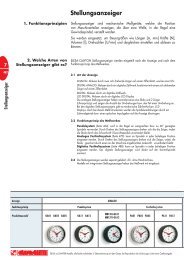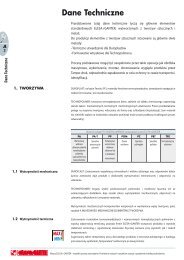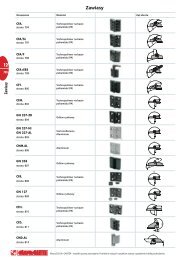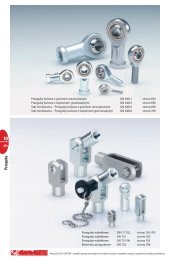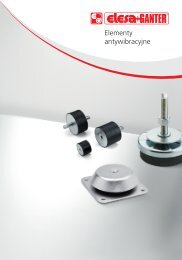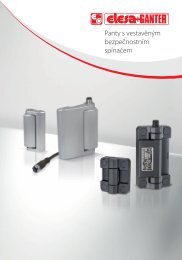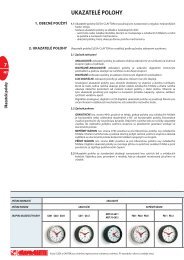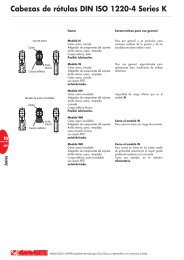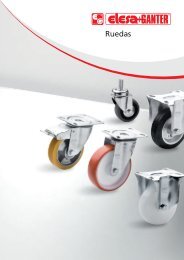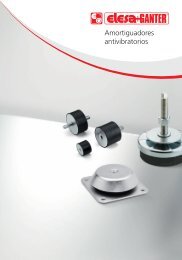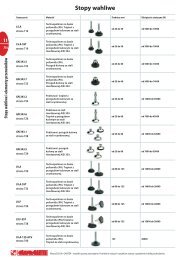Ball joints DIN ISO 1220-4 Series K - CDM - Elesa
Ball joints DIN ISO 1220-4 Series K - CDM - Elesa
Ball joints DIN ISO 1220-4 Series K - CDM - Elesa
Create successful ePaper yourself
Turn your PDF publications into a flip-book with our unique Google optimized e-Paper software.
<strong>Ball</strong> <strong>joints</strong> <strong>DIN</strong> <strong>ISO</strong> <strong>1220</strong>-4<strong>Series</strong> KTechnical informationBearing playBearing play refers to the amount of play by which the internal ring inside a bearing socket without lubrication can be moved in either a radial or anaxial plane.Types N, NHlubrication possibleTypes W, WH, WKself lubricatedd1d1Bore internal ring Radial bearing play Bore internal ring Radial bearing play Axial bearing play5...10 0,005...0,035 5...10 0,005...0,030 2 to 3 times12...20 0,010...0,040 12...18 0,005...0,035 Radial play22...25 0,010...0,050 20...25 0,005...0,045 Radial playLoad applied to obtain the measured results: 100 N at room temperature.Lubrication<strong>Ball</strong> joint heads of type N (lubrication possible) require regular lubrication. On delivery the ball joint heads are not lubricated. The initial lubrication takesplace when installed. Within the temperature range of -20° C to + 125° C, a multipurpose grease proved to be adequate. Under extreme conditions ahigh quality grease such as for instance Gleitmo 805K should be used.<strong>Ball</strong> joint heads of the type W (self lubricated) must never be lubricated. The internal ring moves on a PTFE insert of the bearing socket.Operating temperature<strong>Ball</strong> joint heads of the type N (lubrication possible) can be used within the temperature range -50° C to + 200° C and if used with a high temperaturegrease even higher.<strong>Ball</strong> joint heads of the type W (self lubricated) can be used in the temperature range of -50° C to + 200° C.In general use at higher temperature is possible, but this will of course shorten the working life of the head.Load valuesLoad values are bearing related values, arrived at from the raw material data of the basic material of construction used. The latter is used to determine thechoice of a ball joint head for a given load. These might, however, have to be reduced to meet the requirements of particular circumstances.Static load values CoCo gives the permitted radial static load which can be applied to a ball jointed head with the weakest cross section without causing permanentdeformation. The Co-values quoted in the catalogue table have been calculated, based on the corresponding raw material specification. Subsequently arandom number of the ball joint heads was stress tested at room temperature. Each and every time the stress tests were based on using up to 80 % beforethe onset of deformation thus leaving a safety factor of 1,25.The static load value Co is used to obtain the permissible axial load which in general is limited by the mounting strength of the internal bearing. To obtainthe maximum axial load Fa tests were carried out at the largest permissible slant angle and the results obtained are shown in the table below:Fa = 0,4 Co for type NFa = 0,2 Co for types NH, W, WH, WKStatic load values Co [kN]d1 GN 648.1 GN 648.2 GN 648.5 GN 648.6Size Type N Type W Type N Type W Type NH Type WH Type WK Type NH Type WH Type WK5 9,9 8 4,3 4,3 11,8 11,8 11,8 6,2 6,2 6,26 11,9 8,9 6 6 13,1 13,1 13,1 8,8 8,8 8,88 17,1 14,1 11 11 20,7 20,7 20,7 16,1 16,1 16,110 21,4 19,3 17,4 17,4 28,3 28,3 28,3 25,5 25,5 25,512 27 23,5 25,5 23,5 34,5 34,5 34,5 34,5 34,5 34,514 24,5 21 24,5 21 39,5 39,5 39,5 39,5 39,5 39,516 37 32 36,5 32 60,5 60,5 60,5 60,5 60,5 60,518 43 38,5 43 38,5 73 73 73 73 73 7320 49,5 44 49,5 44 83 83 83 83 83 8322 57 53 57 53 100 100 100 100 100 10025 68 62 68 61 118 118 118 118 118 118Dynamic load value CThey help to evaluate the length of life for ball joint heads when used under dynamic conditions. Nominal values are available if required.10693JointsELESA and GANTER models all rights reserved in accordance with the law. Always mention the source when reproducing our drawings.



